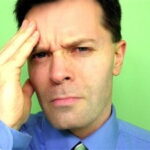Everyone has a headache every now and then. They are common to all of us, but to a small percentage-4 to 5 percent-of us have headaches every day or almost every day and they are called chronic daily headaches. Chronic daily headaches are classified into two groups: primary and secondary. Primary headaches occur in people that have frequent migraines. They manifest so regularly that they never seem to go away. The person has a headache almost every day. Secondary headaches are tension headaches caused by another disease process going on in the body. The frequency and intensity of these headaches makes them very difficult to cope with.
The signs and symptoms of chronic daily headaches vary according to the classification. The symptoms of the primary chronic daily headache include: daily or almost daily headaches, pain in the face, neck and on both sides of the head. There is nausea and sensitivity to sound and light that may fade over time. There also may be occasional migraines that hit and run-these are the ones that come on suddenly, but may not last as long. You can tell the difference between these migraines and the chronic headaches-and with chronic pain there is often problems sleeping, depression, anxiety and panic.
The types of chronic daily headaches include the chronic tension headache, daily persistent, headache, and hemicrania headache-involving one side of the head. The symptoms of the chronic tension headache include: daily or almost daily headaches that started out as only occasional headaches; pain in the back and both sides of the head, and neck; pain may feel like a band of pressure, or be a dull ache that lasts for days. The pain can be so prevalent that it never goes away.
The symptoms of the daily persistent headache include: the pain is described as achy, dull, throbbing, and may manifest in people after an infection. Prior to the infection they had no history of headaches. These headaches may last for several months or years before they go away.
The symptoms of hemicrania headaches include: these headaches are fairly rare. The pain never goes away completely; there may be jolts of intense pain on one side of the head. The patient may experience flashing lights and blind spots in their field of vision. The may experience tearing of the eyes, puffy eyelids, drooping of the eye lid, and nasal congestion. These headaches be constant or come in episodes-lasting for months, followed by weeks or months headache free.
The causes for primary daily headaches may be related to muscle tension due to an inflammatory process going on in the body; impaired pain suppression in the brain; genetic anomalies causing increased pain sensitivities; injury to the upper spine; or overuse of medication. The causes of secondary chronic daily headaches may be related to infection; sleep apnea; inflammation of the arteries and veins, or some other disease process.
Chronic daily headaches present more frequently in women that overuse pain medications more than 9 days a month; have chronic anxiety, depression, and sleep disturbances; are obese; overuse caffeine; and in those who snore. If you are having 3 or more headaches a week you should see your doctor to be evaluated. If you have a sudden onset of headaches after a head injury, of you have fever, rash, stiff neck, seizures or double vision, seek help immediately.
Your doctor will take a history, by asking questions about your headaches-how often they occur and how severe they are. He/she will ask you what the medication you take for them, and what dosage you take to treat the headaches. He/she may do a neurological check on you to check for any problems there; and ask you questions about what diseases and illnesses you have had in the past. You may also be asked to have some scans done, either an X-ray, CT scan or MRI-or any combination of imaging.
A complication related to prescription and OTC pain medications that are taken frequently to relieve headache is that they may cause a side effect of causing rebound headaches. To prevent rebound headaches many doctors treat chronic daily headaches with antidepressants such as amiltriptyline (Elavil) and Fluoxetine (Prozac), which not only helps the headache, but also helps the depression, sleep disturbances and anxiety that are often constant companions of the headaches. Some medications such as beta blockers-that treat blood pressure-are sometimes used in conjunction with antidepressants to treat these headaches; as are antiseizure medications, muscle relaxants and Botox-used as a nerve blocking agent.
You may not be able to avoid chronic daily headaches, but do all you can to avoid what may trigger them. Try to get enough rest and eat right. If you notice that something you eat triggers a headache, try to isolate that food and avoid it in the future. Don’t skip meals; a lowered blood glucose level could be enough to get a headache started. Try to exercise regularly because physical activity releases chemicals that reduce pain. If you smoke cigarettes, try to stop because nicotine has been found to increase tension, anxiety and depression. Try to make your life as simple as possible. Try to stay organized, plan ahead to reduce stress. Take time to relax doing something you like. Listen to music, if you enjoy it. Finding ways to cope with your illness may help you find ways to reduce stress and avoid triggers that cause headaches. You may also want to ask your doctor to help you find a therapist and a support group, if you feel you need a little extra support. Many people find that alternative therapies such as biofeedback, hypnosis, meditation, chiropractic care and massage are very beneficial. Be sure to ask your doctor about any of these therapies if your headaches continue to be bothersome.
Source: Mayo Clinic information page




